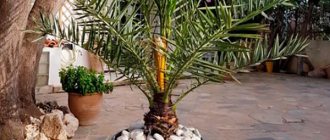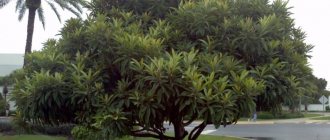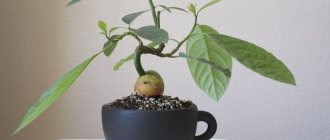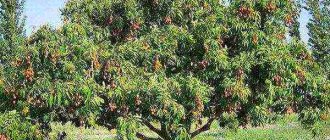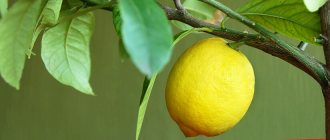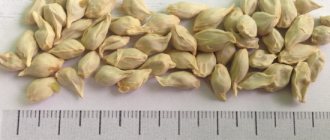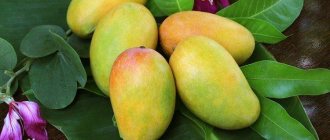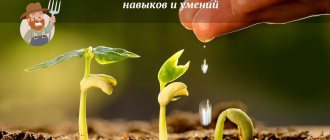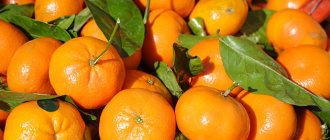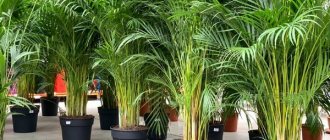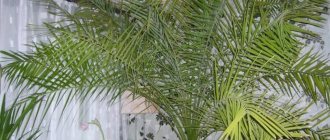How and where do dates grow?
The date tree owes its poetic name “Phoenix” (translated from Latin as “palm tree”) to Carl Linnaeus, a Swedish botanist. It is no coincidence that culture resembles the image of a mythological bird reborn from the ashes.
The photo shows how dates grow in natural conditions.
And there is something symbolic in this comparison, because the palm tree really grows from the hot desert sands, withstanding high temperatures, sandstorms, minimal rainfall, and frequent dry winds.
Under natural conditions, young plants are trees with chaotically arranged leaves, forming almost impenetrable thickets. The cells wait out the heat that comes during the day, at their only point of growth, which is located at the top of the trunk, as if plunging into a kind of suspended animation.
The culture develops and grows only at night, when the temperature drops to low levels. The productive life span of the tree is about 150–200 years; the height of an adult crop reaches about 20–40 m.
The Mediterranean coast of Africa, the Arabian Peninsula, the Middle East, and the Canary Islands are considered the birthplace of the date palm.
As a result of breeding work, the range of the palm tree has expanded significantly, and the industrial scale of tree cultivation has spread to Israel, Australia, Pakistan, Iran, Latin, Central America and the south of the country. But in Europe, the only country where the date tree regularly gifts residents with its tasty harvest is Spain.
Growing this most valuable plant in open ground in Russia is not possible due to the unsuitable climate for cultivating the tree. However, in indoor conditions, the palm tree is maintained and develops quite successfully, representing an element of spectacular, sophisticated interior decor.
Calorie content of dates
Dates of different varieties and processing methods have almost the same amount of calories:
- 100 grams of fresh dates contain 240 kcal
. - Dried dates with pits contain 283 Kcal
, without pits
274 Kcal
. - The most high-calorie date is a dried date with a stone ( 292 Kcal
. - One berry weighing nine grams contains 23 kcal
.
Types of dates that can be grown from seeds
Dates grow on trees (photos of the crop clearly demonstrate its external diversity), ripening for about 8–10 months. According to available data, there are up to 17 types of crops and over 1000 varieties of palm trees bred as a result of breeding work in the world.
It is unlikely that you will be able to get a fruit-bearing tree at home, and even if the berries do appear, they will not be complete. However, decorating an apartment with a lush palm tree is a doable task.
The table shows the types of plants from the seeds of which it is possible to grow an ornamental tree in an apartment:
| Name of varieties | a brief description of |
| Robelena (Phoenix roebeienii) | This miniature date is nicknamed “dwarf” due to its short growth (reaches about 2–3 m). The plant has a thin straight trunk, slightly bumpy below. Openwork dark green with a silver tint, soft foliage is collected in a bunch at the top of the tree. Timidum blooms with yellow buds, and the fruits that appear, although edible, are very tiny - up to 2 mm. The culture is ideal for indoor growing, but requires abundant watering, intense lighting and high humidity. |
| Canary (Ph. canariensis) | A fairly large indoor palm tree is named after the islands of the same name, where it grows in rocky areas. The height of the tree can reach 18 m, the width of the trunk is 1 m. The complex pinnate greenish-gray leaves are divided into approximately 80–100 pieces. narrow and very hard plates. The female (yellow-orange) and male (cream) flowers are collected in large axillary inflorescences. The culture loves bright and well-ventilated rooms. |
| Palmate (Ph. dactvlifera) | This palm tree grows in height up to 15–26, and sometimes up to 30 m. The tree has large leaves, about 6 m long, which crown the top of the plant in the form of a bunch. The buds are collected in paniculate inflorescences. The fruits of the crop are elongated drupes (8 cm) approximately 4 cm wide. |
| Curved (Ph. reclinata) | A feature of the presented palm tree is the presence of several trunks with a total width in diameter of up to 10–17 m. The spreading leaves are shaped like bird wings. The culture, which is more reminiscent of a bush, is quite resistant to sunlight and responds well to frequent irrigation and moist air. |
| Rocky (Ph. rupicola) | A fairly frost-resistant single-stem plant with few, small leaves. The Kamenisty variety has much fewer thorns characteristic of this crop than its “relatives”. The tree reaches a height of 7–8 m. |
Date palms grown at home make this crop an original element when decorating large rooms, lobbies or hallways. Ornamental plants are successfully used in zoning indoor spaces.
What are dates?
Dates are the edible fruits of a tree called the date palm. People have been using them since ancient times as a highly valuable food product. You can buy them on sale in the form of dried fruits. Countries with hot climates grow different varieties of palm trees for industrial scale. When dried, they acquire a sweetish-pleasant taste. We invite you to get acquainted with this delicacy, find out what kind of fruit the date is and where it grows.
Selection and preparation of seeds
Dates grow on trees (photos of high-quality fruits will help you choose good planting material), like huge bunches of grapes. Growing a palm tree in an apartment is not particularly difficult, but it will look somewhat different than in natural conditions.
Initially, you need to correctly select and prepare the seeds, proceeding in the following order:
- Dates that have not been subjected to heat treatment and are within their expiration date are suitable for planting. Dried or dried berries would be a good material.
- First, you need to select at least 10 fruits and remove damaged or moldy specimens.
- Then you need to leave the pulp-free seeds in a thermos with warm drinking water for 48 hours to rid the future plant of microorganisms. The fluid needs to be changed 2-3 times a day.
- When the specified time has passed, the planting material must be washed again, then dried for 24 hours.
- Date pits have a very dense shell. To help the swollen seeds crack faster and release the root, it is recommended to slightly break the integrity of the seeds. To do this, you can carefully file (cut with a knife) their walls or pierce them in several places with a needle.
- Now you have to wrap the processed blanks in damp cotton wool or fabric, creating a kind of cocoon. In this state, the seeds should be kept for several days in a plastic container at a temperature of 20–30 °C. The packaging must be moistened periodically. You need to keep the seeds in such conditions until they hatch.
Some gardeners, without waiting for the sprouts to appear, place the treated seeds in pre-moistened soil and cover the container, thus creating a greenhouse effect inside the container.
How to care for a palm tree at home
When growing palm trees, experts recommend adhering to certain rules. The following points are important:
- absence of drafts;
- watering with soft, settled water;
- wiping the leaves with a damp cloth;
- weekly warm shower;
- fertilizing with minerals and organic fertilizers every two weeks during the growing season and monthly in winter.
Important! Where the date palm grows, cold winds are not allowed in the house.
Watering mode
Watering the date tree is done on the verge of drying out, that is, when the top layer of soil is dry 2-3 cm deep. Watering should be plentiful, and the remaining moisture from the pan should be drained. In summer this is an average of 2-3 times a week. In winter, watering almost stops, but the earthen ball should not dry out completely.
Lighting requirements
Palm is a southern crop. She needs at least 10 hours of daylight. South, south-east, south-west windows are suitable. Very young plants should be shaded from direct midday sunlight.
Home palm
Planting a seed
When planting seeds, you must perform the following algorithm of actions:
- first you need to prepare a deep and narrow box or small plastic cups;
- to prevent moisture stagnation, it is necessary to add a 2-centimeter layer of drainage consisting of charcoal, expanded clay, broken brick or pebbles to the bottom of the container;
- then you need to put ready-made or home-made soil suitable for planting seeds in a container, consisting, for example, of a mixture of sawdust, peat, sand and humus;
- Date seeds should be planted vertically to a depth equal to 1.5 times the length of the seed. Moreover, it is important not to confuse it by placing the seeds with the blunt part facing down with the sharp end sticking out of the ground;
- Next, the planting needs to be covered with soil and lightly watered;
- the box with the prepared seeds should be left in a warm place, after which the soil will need to be sprayed periodically, preventing both the soil from drying out and becoming waterlogged.
It is recommended to cover the planted seeds with glass or film, not forgetting to ventilate the planting twice a day to eliminate excess condensation.
Composition of dates
The composition of dates is rich in fructose, sucrose, and glucose. A large amount of natural sugars supplies the human body with quick energy, which allows you to recover from illness or long-term work.
100 grams of dates contain:
- proteins: 2.5 g;
- fats: 0.5 g;
- carbohydrates: 69.2 g;
- dietary fiber: 6 g;
- organic acids: 0.3 g;
- water: 20 g;
- unsaturated fatty acids: 0.1 g;
- mono- and disaccharides: 69.2 g;
- ash: 1.5 g;
- saturated fatty acids: 0.1 g.
Macronutrients:
- calcium: 65 mg;
- magnesium: 69 mg;
- sodium: 32 mg;
- potassium: 370 mg;
- phosphorus: 56 mg.
Vitamins:
- vitamin PP: 0.8 mg;
- vitamin B1 (thiamine): 0.05 mg;
- vitamin B2 (riboflavin): 0.05 mg;
- vitamin B5 (pantothenic): 0.8 mg;
- vitamin B6 (pyridoxine): 0.1 mg;
- vitamin E (TE): 0.3 mg;
- Vitamin PP (Niacin equivalent): 1.9 mg.
Microelements:
- iron: 1.5 mg.
The fruits of the date tree are rich in vitamins A, B, C, D, K. Minerals: phosphorus, copper, cadmium, iron, potassium, sodium, magnesium, zinc, calcium.
Planting a sprouted seedling
When using fresh and high-quality seeds, the first shoots will appear in about 1–2 months. Young dates are strikingly different from seedlings of other plants - they look more like green, very sharp skewers.
When the seedlings grow up to 10 cm long, they have to be picked. But experienced flower growers advise doing this work after the sprouts have emerged and look like white sticks.
In this case, the plant will be more actively accepted; within a year it will produce 2–3 short and wide leaf blades, while a 10-centimeter sprout will produce a seedling with 1–2 narrow, reed-like leaves.
It is necessary to plant sprouted seeds taking into account the following rules:
- For each sprout you need to choose a separate deep pot, so that later the plant can be easily and painlessly replanted. It should be remembered that dates have a very powerful root system, which requires adequate space.
- At the bottom of the container it is necessary to add a layer of drainage made of charcoal and expanded clay. And also when planting a seedling, it is recommended to use soil in which the seeds have sprouted.
- The substrate for palm trees can be taken as standard, consisting of 1 part of soil (clay/turf/leaf) and humus, as well as ½ amount of peat and coarse sand.
- The sprouted seedling should be planted together with the mother seed, which will provide the new plant with the nutrition it needs for good development.
- This procedure must be carried out with all precautions - any damage to the roots is detrimental to the crop. It is best to use the most gentle transshipment method.
Dates do not tolerate transplantation well, so this should be done annually in spring for a young tree up to 3–5 years of age, then once every 2 years. It is not advisable to disturb adult plants, limiting yourself to replacing the top layer of the formed earthen coma.
Varieties of dates grown in Israel
They mainly grow three varieties of dates:
- "Majul" - meaning "king" - is a name well justified by its popularity and quality of fruit.
- Hai'an dates are incredibly tasty and beautiful fruits. They are collected not fully ripe and stored in special freezers at a temperature of minus eighteen degrees, where they ripen. These dates are yellow in color when fresh, but when dried they turn brownish. Very tasty and sugary in any form. They begin to harvest in mid-September at night (due to the intense heat), from two in the morning to six in the morning.
- Dates of the "barhi" variety - the fruits of this variety also have excellent taste, are yellow when fresh, and can reach the size of a small apple.
Conditions for growing date palms
A tree grown at home has advantages over a plant bought in a store - an indoor plant gets used to the created climate, lighting and care characteristics, therefore, unlike a ready-made specimen, it does not “be capricious”, gets sick less, and develops well.
Temperature and lighting
Dates, which naturally grow on trees, even in the photo seem to be bathed in the rays of the hot southern sun. A palm tree grown indoors also needs plenty of light and warmth, and does not tolerate drafts at all.
For the initial stage of growing a plant in an apartment, it is advisable to choose the most comfortable place, close to the light. An east window is best. On the south side, the crop must be protected from direct sunlight and sufficient soil moisture must be ensured.
When choosing a window sill, you need to take into account the fact that the length of the first sheet will be approximately 15 cm.
For better growth of a young seedling, it is necessary to take into account the following subtleties of cultivating a palm tree:
- The plant must be protected from direct sunlight, which can damage the leaves. The created light partial shade will help to avoid burns.
- Periodically you need to turn the pot with the tree to provide light to all its sides.
- Maintain the temperature in the room with the date no lower than +20–25 °C. In summer, with regular spraying, the plant will withstand temperatures of +30 °C. The palm tree will calmly survive the cold months at +18 °C, but at lower temperatures it can become seriously ill.
- To provide the plant with 12 hours of daylight in winter, it is worth using LED phytolamps.
Gardeners advise periodically, if the weather permits, to “walk” the plant on the balcony or loggia. The tree should be placed away from the window, providing diffused light without direct sunlight hitting the date. It is recommended to organize such exercise from the period when the temperature outside reaches +15 °C.
Air humidity, watering and spraying
For the healthy and full development of the seedling, it is advisable to purchase a hygrometer - a device for determining the level of humidity in a room. This figure must be at least 60%. Too dry air will cause the tips of the leaf blades to dry out.
If a tree grown from a seed sprouted in winter, you need to install an air humidifier or place containers with water next to it. Such adaptations will help the culture quickly adapt to new living conditions.
Drooping palm leaves are a sign of insufficient soil watering. The soil should always be moist, for which in the summer it is necessary to moisten the soil around the roots with warm (up to 33 ° C) settled/boiled water, arranging procedures up to 2 times a week.
An excellent option for such purposes would be melt/rain water. In the spring and summer months, the tree needs frequent (3-4 times a week) watering, in autumn and winter - rare (once every 7 days).
In addition to irrigation, date leaves should be wiped with a damp cloth to remove dust, as well as “water procedures” in the form of a warm shower. It is recommended to cover the ground with a film to prevent excessive moisture. Experienced gardeners advise growing an adult palm tree in almost dry soil with regular spraying.
Soil and pot requirements
Dates grow on trees (a photo of a palm tree allows you to get acquainted with the peculiarities of the culture), which in nature exist perfectly even on rocky slopes. The development of a tree at home largely depends on the quality of the soil. A universal composition or substrate called “Palma” can be purchased at flower shops or prepared independently.
It is customary to add superphosphate to the soil composition (1 tablespoon per liter of soil), which has a positive effect on the tree’s absorption of nutrients such as potassium and nitrogen. The second component has a significant impact on the quality and quantity of foliage.
Stale manure should be mixed with nitrogen and potassium (under no circumstances should such fertilizer be used fresh). And also perlite, brick chips, vermiculite and fine expanded clay should be added to the soil as a loosening agent.
To disinfect the soil, it is necessary to use crushed charcoal. All soil components should be taken in equal quantities. To prevent the date from being attacked by pests, the soil must be calcined in an oven or disinfected with a solution of potassium permanganate (potassium permanganate).
The pot plays an important role in the healthy development of the palm tree. The best option would be containers made of natural clay material. But in plastic, the culture will suffer and wither. Ceramic dishes with wide necks have proven themselves to be excellent.
Such flowerpots look very elegant and aesthetically pleasing, their shape is very convenient for the plant. In this case, you should use tall pots, commensurate with the long and very strong vertical roots, which over time may become cramped in a low container.
For adult specimens with a powerful above-ground part, a wooden tub, a stylish stone pot, or an elegant steel plant pot are suitable. It is advisable that the bottom of the container is raised above the pan so that the roots of the tree do not sour or rot in the liquid.
Fertilizer
Good and timely feeding will have the best effect on the growth and development of the palm tree. For these purposes, you can use store-bought preparations or self-made formulations. For good crop growth, it is allowed to use solutions of ash or starch.
A product obtained from 1 tbsp will help ensure the health of the plant. l. regular sugar, 10 gram bag of fresh yeast and 1 liter of settled water. The resulting warm mixture should be kept for 1.5–2 hours, then diluted with water in a ratio of 1:5, and then watered with the crop. Such a drug will provide invaluable assistance to poorly developing, weak plants.
During the active growth of the tree, it needs to be fertilized with liquid compounds about 2-3 times a month, watering the mixture over the leaves and under the roots. In autumn it is necessary to feed the palm tree once a week, in winter - once a month. Organic and mineral fertilizers must be applied once every 7 days by alternating them.
Trimming
The lifespan of date palm leaves is about 1 year. Then the plates gradually turn yellow and dry out, which necessitates pruning. This must be done with a sharp instrument, leaving a few centimeters from the petiole.
There are no special ways to form a crown. We are talking about sanitary pruning of dried and broken leaves that interfere with the proper development of the crop. Yellowed parts do not need to be removed if they are not affected by disease. Such a nuisance should be dealt with only with the help of antifungal drugs.
The date palm is the most important fruit crop of tropical deserts and semi-deserts
Dates are the fruit of the date palm. All the numerous varieties of dates presented on the world market belong to one botanical species - the palmate date (true date palm).
The fruits of some other date palm species are also edible and are used as food by local populations in the regions where they grow, but these fruits are not supplied to the world market.
Dates are the fruit of the date palm
The true date palm is widely grown in North Africa, West Asia, Pakistan and the dry areas of India. Small palmate date plantations are also found on the Mediterranean coast of Southern Europe, in the hot, dry regions of the USA, in Australia and South Africa. This is one of the few plants ideally adapted to the hot, dry climate of southern deserts and semi-deserts.
Dates are widely grown along the Mediterranean coast, including in Southern Europe.
For date plantations, sunny places with underground aquifers or with the possibility of artificial irrigation are chosen. When planting, seedlings are placed according to a pattern of 8 x 8 or 10 x 10 meters, depending on the varietal characteristics and soil conditions. Scions from adult fruit-bearing plants are used as planting material. Date palm seedlings are very heterogeneous in their economic characteristics and are not used for establishing industrial plantations.
When and how do dates bloom?
The date palm is a dioecious plant. Male and female inflorescences are located on different specimens. Date palms are pollinated by the wind. When establishing commercial plantations, for every few dozen female trees, a male specimen must be planted for cross-pollination. Date palms bloom from February to November, depending on the variety and region. The sex of plants can only be determined during flowering. It takes about a year for the fruit to ripen.
Male inflorescences of date palms do not bear fruit, but are necessary for pollination.
Male date palms bloom in large cystic inflorescences consisting of small three-petal flowers with numerous stamens. For better pollination, the blossoming male inflorescences are often cut and hung in the crowns of flowering female trees.
In the old days, cut male inflorescences were often dried and stored in reserve for several years in linen bags to ensure a harvest of dates even if the male pollinator tree died.
Male date palm flowers have three petals and several stamens.
On female date palm trees, the inflorescences are also arranged in large clusters, but they look a little different.
The female inflorescence of a date palm is the basis of the future date harvest
The female date flower looks like a small ball without petals. In case of successful pollination, a date fruit will grow from each such ball-flower.
Female date palm flowers look like tiny balls without petals.
How do dates bear fruit?
Date palms begin to bear fruit early. The first fruits on female specimens appear already at the age of four. By this time, young palm trees do not yet have time to grow a tall trunk, and clusters of dates often end up lying on the ground. On some plantations, such clusters of fruit are tied to supports to avoid contact with the soil, but this is not always done and not everywhere. That is why dates purchased at the market or in a store are strongly recommended to be washed before consumption, especially in countries with unfavorable sanitary and epidemiological conditions.
Young date palms often have fruit clusters in contact with the ground.
Date harvesting is done by hand. This is very dangerous and hard work. Pickers climb trees and use special curved knives to cut off clusters of ripe fruits, then carefully lower them to the ground.
Harvesting dates by hand is hard and dangerous work.
In the northern hemisphere, the date ripening season lasts from May to December. In May, fruits of early varieties begin to be collected in the south of the Arabian Peninsula. The main harvest in most countries of North Africa and Western Asia takes place from August to October.
Picking dates in Tunisia (video)
An adult date palm can simultaneously have from 3 to 20 large clusters of fruits. The weight of each hand usually ranges from 7 to 18 kilograms. The harvest from young trees is small, only 10–20 kilograms of fruits per tree, but every year it increases and by 15 years the trees already produce 60–100 kilograms of dates per year. The yield of mature palm trees in good conditions can reach 150–250 kilograms of dates per tree annually. Palm trees bear fruit for up to 80–100 years or more; there are known cases of regular fruiting of 200-year-old trees.
On an adult palm tree, several large clusters of dates ripen at once during the fruiting period.
An individual date fruit is a juicy, fleshy berry with one large seed. The color of dates, depending on the variety, is yellow, orange, red or brownish. The size of the fruit reaches 8 centimeters in length and 4 centimeters in diameter. Each fruit contains one large oblong stone with a longitudinal groove.
Each date contains one large oblong seed.
Different varieties of dates are used for food either fresh or dried. Fresh dates can only be tasted in the regions where they grow. Dried fruits that can be stored for many months are supplied to the world market. Depending on the variety, they turn out soft, semi-dry or dry.
The benefits and harms of dates
Dates are a very popular sweet treat that can replace candy and sugar. They contain small amounts of B vitamins, carotene (provitamin A) and vitamin K. Among minerals, dates are especially rich in potassium, and also contain calcium, phosphorus, magnesium and small amounts of iron, sodium, zinc, copper and manganese. The high potassium content makes dates beneficial for cardiovascular diseases. The calorie content of dates is very high and reaches 280–340 kcal per 100 grams of product, depending on the variety.
Sweet, high-calorie dates are strictly contraindicated for diabetes and obesity. Healthy people should not overuse this delicacy.
Sweet and tasty dates are just a popular delicacy, but not a panacea for all diseases.
The articles that flood the Internet about the mythical super-health benefits of dates have absolutely no scientific basis.
Yes, dates are indeed one of the staple foods of the poor population of the tropical desert zone, but this happens only for the banal reason that other agricultural plants simply do not survive in the hot and dry desert climate.
What are king dates and where do they grow?
Royal dates are the commercial trade name for the fruit of the Medjoul date palm, grown in many countries in North Africa and Western Asia, as well as in South Africa and the United States. Royal dates differ from other varieties only in their larger sizes and nothing else; their chemical composition is completely identical to other varieties.
Royal dates are the fruits of the large-fruited Medjoul date palm.
Royal date plantation on video
Date pests and diseases
Dates grow on trees (the photos clearly demonstrate signs of painful palm lesions), which, in the process of evolution, have perfectly “adapted” to natural habitat conditions. The house plant, although rare, is still susceptible to diseases and attacks from pests, so the tree must be carefully protected from such misfortunes.
The table shows sometimes occurring crop damage and possible methods of treatment, as well as methods for getting rid of insects:
| Pests/diseases | Symptoms | Control/treatment measures |
| Gray spot | A sign of the disease are spots formed on the leaves, often affecting old plates. As the disease progresses, it appears as black spots - fungal spores. | The treatment procedure consists of removing infected leaves and treating the plant with fungicides - Mancozeb or Ridomil. |
| Mealybug | Easily removable white spots appear on the leaves. | To get rid of the disease, you need to moisten a swab in alcohol, wipe the leaf plates of the crop with it, then treat the plant with anticocidal agents. |
| Shchitovka | Part of the tree leaf becomes transparent, gradually turns yellow, and parasites are present on the leaf blades. | Each palm leaf should be washed with tobacco infusion or soap solution. After this, you need to give the tree a warm shower, then you need to dry the plant, and then treat it with a concentrated composition of Aktara and Calypsa. The procedure must be carried out at least once a week, with at least 4 sessions. |
| Trips | The leaves lighten on top and turn brown at the bottom, gradually the plates soften. | The affected areas of the tree should be removed, then the palm tree should be sprayed with Fitosporin or Topsin. |
| Spider mite | Yellow/brown spots appear on the leaves, then gray plaques, after which a thin web forms. | The plant should be treated with an infusion of onion/garlic peels or Fitoverma or Actellik. |
To prevent insects from entering the room where the palm tree is kept, windows and vents should be equipped with a mosquito net.
Why do date palm leaves turn dark?
The culture is very attractive to insects such as:
- mealybug;
- spider mite;
- Scale insects.
Infestation by these pests leads to darkening and drying of the leaves. You can get rid of the scourge using a solution of laundry soap or diluted garlic juice. You can use an insecticide, such as actellik.
A healthy plant serves as decoration for residential premises and recreational areas in institutions. This is where the benefits of palm trees end. You cannot expect flowering and fruiting from them. However, the decorativeness of the exotic completely compensates for this shortcoming.
Possible problems that arise when growing palm trees from seed and their solutions
Growing a date tree from seeds is a long process that requires attention and proper care.
During the period of development and maintenance of culture, the following problems may arise:
- Drying of new shoots, rotting of the base of the trunk. The cause of such damage is careless spraying of the tree with moisture entering the outlet, waterlogging of the soil, or insufficient lighting of the crop. To correct the situation, you need to reduce watering and irrigation of the hip, provide it with additional light, and sprinkle the rotten areas of leaves and stems with Fundazol or Tetracycline.
- Slow tree growth. The reason for this phenomenon may be depletion of the soil or insufficient volume of the pot for the root system. In this case, the palm tree should be transplanted into a larger container using the method of transshipment, then water the plant with Zykron solution once a week.
- Yellowing of leaf tips. Similar symptoms occur due to low indoor humidity and lack of nutrients in the soil. To eliminate the defect that has arisen, it is necessary to frequently spray the plant with warm, settled water in conditions of high air temperature.
- Drying lower leaves of a palm tree. The reason for this problem is the age of the leaf blades of the crop, which is considered a completely normal phenomenon. Dried leaves should be removed. However, if this is observed in relation to young shoots or concerns the rosette of the plant, other measures must be taken to treat the tree.
- Yellowing of the leaf blade , when the veins remain green, is characteristic of leaf chlorosis. The reason for this is a disruption in the formation of chlorophyll in the plates. You can compensate for its deficiency with the help of fertilizers and various stimulating compounds.
In order for the date palm to grow healthy and strong, 6 months after planting in the pot, the top layer of soil should be periodically enriched with nutrients.
Possible problems during cultivation
Some gardeners are faced with a situation where a date stops growing for no apparent reason. This may happen due to the following factors:
- Lack of heat. At air temperatures below +17 °C, the roots of the plant cease to function properly, and the nutrients necessary for growth do not enter the trunk.
- Incorrect soil composition. The palm tree does not like soils with acidity below 7 pH. A lack of manganese and iron in the soil may also be to blame.
- Pot too big. The aboveground part of the plant will not grow until the roots fill all the available space.
How long does a date grow in indoor conditions?
A date palm grown at home goes through certain stages of development. The first 2 years the plant resembles tough grass. Thickening of the leaf blades, which remain continuous or partially divided, begins in the third year of the date's life.
The plant discards its first full-fledged, long and dissected shoot in 4-5 years. At this stage, you need to select a large flowerpot that will provide a permanent and most comfortable habitat for the crop.
Dates grown indoors are unlikely to appear on trees, but after 5 years a luxurious palm tree with a fluffy trunk and wide spreading leaves will take a central place not only in the interior of the room, but also in a colorful photo among other photographs of the best house plants.
Benefits of dates
Dates are loved by adults and children. The delicacy is not only tasty, but also healthy. If candies and ordinary sweets only destroy gums and tooth enamel, then dates strengthen them. They contain all the most important vitamins and minerals. They also contain niacin and pantothenic acid. These substances are very beneficial for the skin and hair, and benefit vision and the liver. The potassium and magnesium they contain help prevent heart disease. The dietary fiber (fiber) present in these dried fruits improves digestion. They help lower cholesterol and stabilize blood sugar levels. Dried dates contain a high concentration of antioxidants.
In another way they are also called “bread of the desert.” The great advantage of dates is that they are not treated with sulfuric acid, like other dried fruits. For example, among the Chinese there are many long-lived people whose diet includes dates. They not only increase a person’s life expectancy, but also make him hardy, strengthen the liver, kidneys, and heart. Dates stimulate the nervous system and help the body fight infections, including viral ones. These dried fruits prevent diseases such as: hypertension, anemia, breast and lung cancer. They can soothe a cough and speed up the removal of mucus.
Useful properties of dates and their use in the food industry
- This exotic fruit contains a large amount of dietary fiber, some of which are soluble and others insoluble; they prevent the rapid absorption of sugar, so their glycemic index is low. Eating dates gives you energy and gives you a long-lasting feeling of fullness.
- Date honey, silane, is very highly valued and very popular in the east. To make it, the fruits are peeled and pitted, then the juice is extracted, which is diluted with special sugar water and evaporated until the liquid reaches the consistency of molasses, then the “honey” is poured into pre-sterilized jars and closed. The shelf life of such a product is very long, and the benefits of eating it can hardly be overestimated.
- A natural sweetener is made from dates.
The fruit contains a huge amount of useful substances : vitamins A, B1, B2, folic acid, potassium, phosphorus, calcium, etc. They also contain a large amount of calories - approximately 200 kcal. per 100 g. Many claim that a person can live for a very long time on dates and water alone.
In cooking, there are a huge number of recipes for preparing various dishes with the addition of date palm fruits: sweet pilafs, a variety of pastries, sweets, jams , drinks and much more.
Harvest
In the third or fourth year you can expect the first fruits, but a full harvest appears in the 5-6th year of the tree’s life. Dates usually bear a huge number of fruits; there are cases when, under their weight, during gusts of wind, the palm trees themselves even break. The tree holds the record for the number of years and fruit yield. On average, a palm tree bears fruit for 60-80 years. In the 5th-6th year, each tree bears up to 10 kg of fruit, and from about the 13th year, the yield can reach about 80 kilograms; you can even harvest up to 150 kg of fruit from one tree.
Planting and caring for a date palm
The finger date, unlike other palm trees, has very good cold resistance. A tree accustomed to the extreme heat of the desert can survive long-term temperatures down to -14ºC.
This palm is practically indifferent to the quality of the soil. In nature, the tree successfully exists on bare sand. This is possible due to the fact that its root system is very powerful and developed. The rod goes ten meters or even more into the soil, feeding from groundwater. By the way, the ancient Arabs, focusing on date palms, laid out caravan routes. If these trees grow somewhere in the middle of the desert, there is definitely water nearby, you just need to find it. The crop also successfully takes root in heavy clay and poor rocky soils. Even the high level of salinity of the substrate does not frighten her.
Considering the extremely few “requirements” of the plant, date plantations are planted in open, well-lit and sun-warmed areas. Winds, even the strongest, are no hindrance to palm trees. The main thing is to make sure that there is groundwater in the selected area or to build an artificial irrigation system. And also give each plant sufficient area for nutrition, otherwise they will simply begin to “strangle” each other. Depending on the variety, 8–10 m are left between neighboring palm trees, and the row spacing is approximately the same.
Date plantations are planted where the plants receive enough heat and sunlight
Exclusively the root shoots of adult fruiting palms are used as planting material. Planting seedlings obtained from seeds is a kind of lottery, which cannot be afforded when growing fruits on an industrial scale. The varietal characteristics of such plants vary greatly. At home, on the contrary, cultivating date palms grown from seeds with one’s own hands is extremely popular. Anyway, they basically don’t bear fruit.
In Russia, date palms are grown mainly at home; they develop rather slowly
Video: date plantation
The Russian climate, as it was found out experimentally, is categorically not suitable for cultivating date palms on an industrial scale. They need the tropics, or at least subtropics. The Black Sea coast meets this requirement, but the culture there is not satisfied with high humidity. In the Sochi region, for example, date palms are planted exclusively as ornamental plants. They bloom, sometimes even fruits ripen, but their quality is extremely low.
At the same time, young plants under the age of 10 years can be irreversibly damaged even when the temperature drops to -8–10ºС. Therefore, for the winter, the bases of the stems are wrapped in several layers with any breathable covering material and covered with straw or reed mats. Be sure to cover the apical growth point as well. Sawdust, peat and sand are added to the planting hole, without fertilizers at all.
DATE FROM PIT
If you suspect that you have a penchant for experimental botany, immediately plant a date seed in a pot of soil. and then you will be able to watch the date palm growing on the windowsill. In 10 years it will turn into a real tree!
WHERE DO DATES GROW?
Huge date palms immediately catch the eye of tourists who visit the green oases of Egypt, Israel and other countries of North Africa and South-West Asia. Usually they tower above the entire surrounding area, representing perhaps the tallest trees - 15-20 meters each with a straight and thick unbranched trunk, at the top of which up to fifty huge feathery leaves rustle and sway.
Man has been growing date palms since ancient times. And not so much for the beauty of the landscape, but for practical purposes. Their fruits are tasty and nutritious, containing a huge amount of vitamins, mineral salts, sugars and other useful substances. The local population prepares hundreds of different dishes, drinks, and potions from them.
To avoid disappointment, I warn you in advance that a palm tree grown in your home, alas, will not produce fruit.
SUBTLES OF FITTING
You can, of course, without much thought, put a seed in a pot with some indoor flower as either a “neighbor” or a “guest”. It is quite possible that by some miracle the date will survive, at least grow, and then displace its former owner, fighting for existence.
But it is much more effective to do otherwise.
Experienced experimenters know that the hard shell of fresh seeds prevents the rapid appearance of sprouts. Sometimes they try to file it or soften it with hot water. I advise you to do without these extremes and simply create the best conditions for seed germination using two simple operations. First, place the seeds in a thermos with clean and slightly warmed snow water for two days - ideally with a tiny addition of natural biostimulants - sodium humate preparations. And after that, transfer the bones to any small closed container with damp hydrogel, sphagnum moss or at least sawdust and keep it near a central heating radiator for a month and a half, where the temperature is 30-35°C.
After 3-4 weeks, the swollen seeds will have to be checked periodically: they should not dry out. And when spiky sprouts appear, immediately plant them in pots 10-12 cm high with loose, moist soil - a mixture of turf soil, peat and sand in equal parts. Moreover, it is better not to stick the sprouted seeds vertically, but to lay them horizontally, cut side down, covering them with 2-3 cm of soil. Do not rush to move your plantings to a cool windowsill, where the air is also excessively dry. Things will go much faster if, until the seedlings emerge (no lighting is needed until this point), you place the pot inside a transparent and tightly tied plastic bag and keep it in a warm place, for example in the kitchen, not far from the stove.
When planted in winter, shoots resembling thick green carnations will appear in the spring, but not earlier than April - May, when it becomes warmer on the windowsill and there is no threat of frosty drafts. The optimal temperature for seedlings is 20-25°C. Subsequently, grown date palms tolerate temperatures of 12-15 degrees in the winter-spring months, and in the summer months - with the temperature that occurs in the middle zone. The main thing is that the plants receive the maximum amount of light and stand as close to the glass as possible.
Dates: where they grow, calorie content, benefits and harm
Doctors say that 10 dates a day is enough to provide your body with the daily need for magnesium, copper, sulfur, calcium, iron and other useful elements. Dates are one of the most famous oriental delicacies. Many people believe that they cannot harm our body, but is this true? In this article on the website elgreloo.com you will learn where dates grow, what benefits and harm they can cause to our body, and also what can be prepared from this oriental delicacy.
Where and how do dates grow?
These fruits grow on the date palm. One tree grows for about 60 years and brings an abundant harvest every year. The homeland of dates is the territory of Saudi Arabia, Egypt, Morocco and Tunisia. Today, the most important country for the production and export of dates is Saudi Arabia, followed by Egypt, Bahrain, Iran, Syria, Tunisia, Algeria and the United Arab Emirates. A good harvest from a date palm is obtained in 5-6 years of growth. From one tree you can collect approximately 50-80 kg of fruit.
Dates: their benefits and harm
The fruits of the date palm are tasty and nutritious (100 grams contain more than 300 kilocalories), but not everyone can eat them, since dates contain a lot of sugars (about 70 percent). They are not recommended:
- patients with diabetes mellitus;
- prone to obesity;
- suffering from peptic ulcer disease;
- having allergies;
- patients with gastritis with high acidity.
Coarse fiber, contained in large quantities in fruits, irritates the mucous membrane of the digestive tract. But for constipation, dates are recommended. These fruits are useful for gout and urolithiasis, since they do not contain purine bases. The end product of the breakdown of purines is uric acid, an increase in the content of which is unfavorable for the patient’s body.
Dates are rich in mineral salts, especially potassium and iron. And since potassium is known to play a large role in the regulation of water-salt metabolism and cardiac activity, dates should be included in their diet for those who have heart and vascular diseases, of course, if there are no diseases of the stomach and intestines. The iron contained in dates helps enrich the blood with oxygen and activates cellular respiration. They also strengthen gums and teeth, hair, help improve skin condition, and also have a positive effect on our vision and liver.
Doctors advise pregnant women to consume dates. They are included in the astronaut menu. Some argue that a person can eat only this oriental delicacy for 2-3 months without depriving his body of vital vitamins and minerals. After all, these fruits contain a huge amount of vitamins A, B, C. Below is a list of diseases that dates help with:
- Heart diseases;
- Nervous paralysis of the facial nerve;
- Nervous fatigue;
- Dystrophies (date decoction);
- Makes childbirth easier.
Calorie content of dates. How many dates can you eat per day?
100 g of the edible part of these dried fruits contains 150-275 calories, if eaten dried or dried - 340 kcal. As you may have noticed, they are quite high in calories and therefore you can quickly get enough of them. If you decide to go on a diet, but find it difficult to give up sweets, then dates will be an excellent substitute for sweets. Many mothers are interested in whether it is possible to give dates to their children. Of course! 2-4 pieces per day will be enough.
Useful properties of dates
- 100 g contains a large amount of dietary fiber. For this amount of dried fruits 6.7g. They normalize intestinal function and remove toxins.
- Pantothenic acid regulates metabolism. It also improves immunity, controls the functioning of the nervous system and adrenal glands.
- Vitamin A. Your nails will become strong and beautiful. And your hair will be healthy, the ends will stop splitting.
- Potassium. Just 150-200 g of dates replenish the daily need of potassium in the body. We need this element because it maintains normal cardiac muscles.
- Calcium. We need this macronutrient because the strength of our bones and teeth depends on it.
In addition to the above properties, this dried fruit contains thiamine, riboflavin, niacin, pyridoxine, folacin, and vitamin D.
What can you cook from dates?
A huge number of dishes can be prepared from this oriental sweetness. In this section we will look at one recipe. You can make a cupcake using these dried fruits. To prepare it you will need:
- Dates - 125 g; - 1 PC;
- Pecan nuts - 50g;
- Raisins - 100g;
- Kishmish - 100g;
- Cinnamon - 1 tsp;
- Baking powder - 1 tsp;
- Dark rum - 1.5 tbsp;
- Egg white - 1 piece;
- Polenta - 50g.
Turn on the oven at 180 C. Then place parchment paper in a rectangular shape. Remove the pits from the dates and pour 100 ml of boiling water over the fruits themselves. Put on fire and let simmer for 5 minutes. Then you need to drain the water, put the dates in a blender and puree. Add banana, a little water and mix everything again.
Take a bowl and combine nuts, raisins, spices, baking powder, polenta, rum and date-banana mixture. Beat the egg white until foamy and carefully mix into the dough. Place this mixture in a baking dish and smooth it out. You can decorate the top with nuts. Place in the oven and wait 1 hour. Check the readiness of the cake using a wooden stick. Allow to cool and then remove from the mold. It is necessary to cut it when it has completely cooled down. Otherwise it will fall apart. Bon appetit!
As you may have noticed, dates are very beneficial for the human body. You can add dried dates to almost any dish. Add to oatmeal, ice cream, and decorate baked goods in the morning. A little of your imagination and you can please your loved ones and family with a new dish.
Date palm: what kind of plant, description, what it looks like
Date (lat. Phoenix) is a dioecious plant, belongs to the Palm family (lat. Arecaceae). The genus includes more than 14 species, most of which are known for their nutritious and sweet fruits.
fruit tree
Some species are shrubs, but the best known are those that form during their lifetime a tall single trunk with a lush crown of hard, long, pinnately dissected leaves (veil) of a dark green color with sharp spines at the base.
During flowering, long paniculate inflorescences grow, uniting many small yellow flowers. Male flowers differ from female ones in their structure. A female flower has 3 pistils and 3 petals, while a male flower has 6 stamens. The fruit is a berry with one large seed inside.
Note! The real or true date is the palmate date (lat. Phoenix dactylifera), reaching a height of 30 m. Its fruits are eaten, and its wood is used as a building material. The tree survives frosts down to -14 °C.
This is what a date leaf looks like
Can it be kept at home?
The date tree is a plant that can be grown in almost any apartment or office where there is enough free space for it.
A specimen aged 5-7 years has a leaf span of up to 2.5 m in diameter. It does not require any special lighting, and the air temperature is suitable within +15..+35 °C.
Note ! The closer the conditions are to natural ones - very bright light and high air temperature, the faster the palm tree will grow.
Female inflorescence
Dates for weight loss: is it possible or not and how much?
Dried dates, like all dried fruits and nuts, are high in calories. On a weight loss diet, you should not avoid any type of food and take care of a sufficient supply of energy every day, which is selected individually for the patient, taking into account his anthropometric characteristics, age and nutritional goals.
You can eat dates while on a weight loss diet. But provided they are consumed in controlled quantities. For example, as an addition to 3-4 pieces of muesli or a natural sugar substitute in healthy homemade baked goods.
The question of how many dates you should eat during a diet can be answered as follows: Dates are a rich source of potassium, dietary fiber and simple carbohydrates. They are successfully used for home baking as an element that gives an interesting taste and aroma, an addition to meat and an independent snack. People on a weight loss diet also do not need to give up eating these delicious fruits, but they should pay attention to their quantity.
